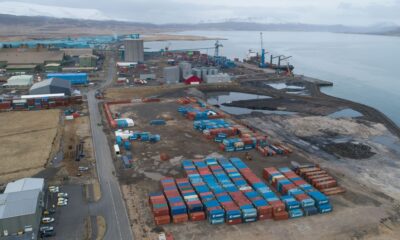Tech
How to Keep Subways and Trains Cool in an Ever Hotter World

TfL, to its credit, has made many efforts over the years to try to deal with the problem of hot tunnels, including attaching cooling panels to tunnel walls. The panels, which circulate water to remove heat from the air, were deployed in a trial in 2022, though they are not currently in use. Paul argues that such a system could be prohibitively expensive.
Hassan Hemida at the University of Birmingham says Paul’s water-cooling technology is a “good idea,” though it remains to be seen how much heat it could really remove from a real-life, busy Tube station full of people.
Certain railways simply push the boundaries of our ability to cool things down, says Hemida. He gives the example of super-high-speed trains traveling at, say, 400 kilometers per hour. They force air out of their way at high velocities, meaning the air pressure surrounding heating, ventilation, and air-conditioning (HVAC) equipment on the roofs of those trains can drop significantly. “Then, you cannot suck air into the HVAC system,” he says. Ultimately, that could cause the air-conditioning unit to fail. “I have been contacted by colleagues from China, and they want to find a solution for this problem,” Hemida adds.
More and more train operators are adopting air-conditioning systems as standard, though. London’s still relatively new Elizabeth Line features air-conditioning, for example. And a spokesman for Škoda Transportation, which recently rolled out air-conditioned metro trains in the capital of Bulgaria, says: “Generally, every vehicle we produce now is equipped with AC.” Sharon Hedges, senior engagement manager at Transport Focus, an industry watchdog, adds: “As people think about procuring new rolling stock, these are the kind of things that need to be uppermost in minds now.”
Heat waves are one thing in Britain. What about the Egyptian desert? German tech company Siemens is supplying Egypt with a new set of high-speed trains that can travel at speeds of up to 230 kilometers per hour. The firm’s Velaro trains are used in many places around Europe, but for Egypt, Siemens has really put them through their paces. Last summer, the company took one of the trains to a test facility in Austria and exposed it to unpleasant conditions, including temperatures as high as 60 degrees Celsius and high winds. “We are achieving 26 degree inside temperature at the hottest outside conditions,” says Björn Buchholz, head of HVAC and door systems.
Tech
Loop Earplugs Offers: Quiet 2, Sweet Dreams and Gift Set Discounts

Loop earplugs are some of the best reusable earplugs you can buy. I personally keep a pair attached to my car keys at all times. As a live music enthusiast that frequently travels to some of the loudest music festivals on the planet, I take earplugs seriously. I want to protect my hearing while also ensuring the sound isn’t muddy and muffled. These are worth it, especially when they’re even cheaper with a Loop earplugs discount code. They’re comfortable and reduce noise without obscuring the music, ensuring that you have an excellent experience without compromising your hearing the next day.
Loop earplugs come with multiple ear tip sizes so you can find the best fit, plus a handy carrying case that’ll keep them clean and easy to find between uses. I also really like how they look in your ears. They’re almost like jewelry. They stay comfortable and secure—I’ve worn mine for over twelve hours at a time, and I love them so much that I’ve purchased them with my own money (even without a Loop earplugs promo code). Your ears will thank you later.
Loop Earplugs Quiet 2 Deals: Protect Your Ears and Reduce Noise
The Quiet 2 are the best Loop earplugs for sleep. They can block out up to 27 dB of noise and they’re made out of soft silicone, so they’ll stay comfortable even if you’re a side sleeper. They’re snug, secure, and small-ear friendly. We also appreciate that they come in multiple colors and that they’re easy to clean with some soap and water.
Save 20% on the Sweet Dreams Gift Set: Loop Dream + Loop Engage 2
This Daily Calm bundle is perfect for everyday noise reduction. You’ll get the Loop Engage 2 Plus, which are basically like noise-canceling headphones for your day-to-day life. They filter out just a little bit of noise—16 dB by themselves, or 25 dB with the included Mute accessory—so you can stay engaged in conversations without getting distracted or overstimulated. The Loop Dream are meant for sleep, with an entirely silicone design and a very low-profile fit, and with a Loop earplugs promo code, they’re 20% off.
20% Off Dreamville Gift Set: Sleep Better, Wake Refreshed
This Dreamville gift set bundle is perfect if you’re looking for Loop earplugs for concerts. It comes with the Loop Experience 2, my favorite earplugs for loud music festivals, in a special Tomorrowland color scheme. Now at 20% off with this Loop earplugs discount code, you’ll also get a connector cord that keeps the earplugs attached around your neck for easy access when you need to pop them in and out. Also included is a pair of Loop Dream earplugs for sleep, which will help you catch some shut-eye even if your festival neighbors are partying until sunrise.
Star Student Gift Set: 20% Off for Focused Study and Sleep
Shop this Loop earplugs sale to get two pairs for 20% off that are great for students. The Loop Quiet 2 helps to dampen the noise around you, like when you’re locked in at the library trying to finish up an essay. And the Loop Engage 2 can help you stay focused during long and lengthy lectures when your fellow students are yapping in the background.
Tired Parent Gift Set: Buy One Dream, Get the Second 50% Off
Do you know some parents in need of better shut-eye? This Tired Parent gift set bundle includes two pairs of Loop Dream in your choice of four different colors, with the second part at 50% off right now. These all-silicone earplugs will assist in both falling and staying asleep—whether you’re trying to muffle a snoring partner, a colicky baby, or the too-loud, battery-operated toys that your kiddo got for their birthday, these will come in handy.
Tech
Here’s What’s in the DOJ’s Epstein File Release—and What’s Missing

Much of the imagery is familiar from previous releases, and includes things like a photo of a stuffed tiger, a photo of a framed Times of London cover of Princess Diana placed at the back of a closet, photos of the many paintings of nude women in Epstein’s townhouse, and framed photos of Epstein associates like Trump and Woody Allen.
Volume 2
The second volume contains 574 photos and one four-second video. Many of the photos feature Epstein and Maxwell in various locations. Several celebrities and politicians also appear in the photos, including actors Chris Tucker and Kevin Spacey, singer Michael Jackson, and Rolling Stones guitarist Keith Richards—none of whom appear in suspicious or compromising positions.
However, Bill Clinton appears multiple times in the second batch of images. In one photo, he is shirtless in a pool with a woman whose identity has been redacted; a photo that appears to have been taken at the same location shows Clinton and Maxwell in the pool. Clinton also appears in multiple photos with women whose identities have been redacted.
Clinton took four trips with Epstein in 2002 and 2003, including a humanitarian trip to Africa and London. During a portion of that trip, he was accompanied by Tucker and Spacey, according to The New York Times.
(Clinton spokesperson Angel Ureña released a statement reading, in part, “They can release as many grainy 20-plus-year-old photos as they want, but this isn’t about Bill Clinton.”)
Dozens of photos feature Jean-Luc Brunel, a modeling agent and close friend of Epstein’s. The photos show Brunel with Epstein and Maxwell in multiple locations, as well as aboard what appears to be Epstein’s infamous private jet. In several images, Maxwell is seen massaging Brunel’s feet and sticking one foot between her breasts.
Brunel was arrested by French authorities in 2020 as part of a sex trafficking and sexual assault investigation into Epstein, and charged with rape of minors over 15 and sexual harassment. Brunel denied any wrongdoing. In 2022, Brunel was found dead, hanged in his jail cell.
Volume 3
The third volume contains several hundred photos. One of those, which appears to have been framed, shows a man who appears to be Prince Andrew posing on his side on the laps of at least four women, whose faces are all redacted. A smiling Maxwell, and a woman whose face is redacted, stand in the background.
Many of the photos, however, may have been printed out as they appeared in digital storage, since the individual photo names, the file extensions, and album names are all visible. Many images with those markers include Clinton, and several were seemingly taken on a group vacation to Thailand that Clinton is alleged to have taken with Epstein and Maxwell. Clinton also joined the couple for at least one leg of a multiple-destination vacation that stopped in China, Paris, and Stockholm, another that stopped in New York, Los Angeles, and London, another trip to Africa and London, and another trip to Morocco. In one photo, Clinton is shown with a woman, whose face is redacted, sitting on Clinton’s lap.
Tech
Scammers in China Are Using AI-Generated Images to Get Refunds

I don’t want to admit it, but I did spend a lot of money online this holiday shopping season. And unsurprisingly, some of those purchases didn’t meet my expectations. A photobook I bought was damaged in transit, so I snapped a few pictures, emailed them to the merchant, and got a refund. Online shopping platforms have long depended on photos submitted by customers to confirm that refund requests are legitimate. But generative AI is now starting to break that system.
A Pinch Too Suspicious
On the Chinese social media app RedNote, WIRED found at least a dozen posts from ecommerce sellers and customer service representatives complaining about allegedly AI-generated refund claims they’ve received. In one case, a customer complained that the bed sheet they purchased was torn to pieces, but the Chinese characters on the shipping label looked like gibberish. In another, the buyer sent a picture of a coffee mug with cracks that looked like paper tears. “This is a ceramic cup, not a cardboard cup. Who could tear apart a ceramic cup into layers like this?” the seller wrote.
The merchants reported that there are a few product categories where AI-generated damage photos are being abused the most: fresh groceries, low-cost beauty products, and fragile items like ceramic cups. Sellers often don’t ask customers to return these goods before issuing a refund, making them more prone to return scams.
In November, a merchant who sells live crabs on Douyin, the Chinese version of TikTok, received a photo from a customer that made it look like most of the crabs she bought arrived already dead, while two others had escaped. The buyer even sent videos showing the dead crabs being poked by a human finger. But something was off.
“My family has farmed crabs for over 30 years. We’ve never seen a dead crab whose legs are pointing up,” Gao Jing, the seller, said in a video she later posted on Douyin. But what ultimately gave away the con was the sexes of the crabs. There were two males and four females in the first video, while the second clip had three males and three females. One of them also had nine instead of eight legs.
Gao later reported the fraud to the police, who determined the videos were indeed fabricated and detained the buyer for eight days, according to a police notice Gao shared online. The case drew widespread attention on Chinese social media, in part because it was the first known AI refund scam of its kind to trigger a regulatory response.
Lowering Barriers
This problem isn’t unique to China. Forter, a New York-based fraud detection company, estimates that AI-doctored images used in refund claims have increased by more than 15 percent since the start of the year, and are continuing to rise globally.
“This trend started in mid-2024, but has accelerated over the past year as image-generation tools have become widely accessible and incredibly easy to use.” says Michael Reitblat, CEO and cofounder of Forter. He adds that the AI doesn’t have to get everything right, as frontline retail workers and refund review teams may not have the time to closely scrutinize each picture.
-

 Business7 days ago
Business7 days agoHitting The ‘High Notes’ In Ties: Nepal Set To Lift Ban On Indian Bills Above ₹100
-

 Tech6 days ago
Tech6 days agoFor the First Time, AI Analyzes Language as Well as a Human Expert
-

 Business5 days ago
Business5 days agoKSE-100 index gains 876 points amid cut in policy rate | The Express Tribune
-

 Sports5 days ago
Sports5 days agoJets defensive lineman rips NFL officials after ejection vs Jaguars
-

 Business5 days ago
Business5 days agoStudying Abroad Is Costly, But Not Impossible: Experts On Smarter Financial Planning
-

 Business1 week ago
Business1 week agoIPO Explained: Meaning, Process, Benefits, Risks
-

 Tech1 week ago
Tech1 week agoCursor Launches an AI Coding Tool For Designers
-

 Sports7 days ago
Sports7 days agoSource: U-M launches athletic department query















